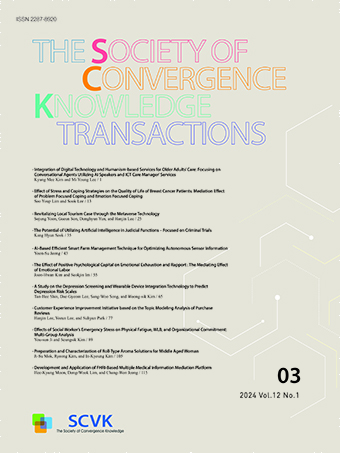Research Article
Abstract
References
Information
중년기는 삶의 여러 측면에서 중요한 변화와 도전을 겪는 시기로, 생리학적, 심리학적, 사회학적으로 많은 변화가 발생하는 시기이다. 이때, 여성은 생리 기능의 감소와 관련된 폐경을 경험하며, 정신적, 감각적, 생식적인 변화와 성 정체성에 대한 고민, 외모 관련 스트레스, 가족 구성원 간의 변화로 인해 스트레스를 느끼게 된다. 한국의 중년 여성 중 약 38~39%가 갱년기 증상을 경험한다. 이런 문제점을 개선하고자 EEG(Electroencephalogram)를 통하여 아로마 솔루션이 중년 여성 증상을 개선하는지 보고자한다. 실험에 사용한 아로마오일은 Bergamot oil과 Clary sage oil을 사용하고, Carrier oil로서 무색, 무취인 MCT(Medium chain triglycerides) oil도 함께 사용하였다. 아로마 솔루션 비율을 정하기 위해 실험 대상(50세, 여성)에게 Bergamot:Clary sage:MCT oil 비율을 각각 다르게 하여 최상의 비율을 뇌파 분석을 통해 결정하였다. 제조한 아로마 솔루션을 중년 여성 8명 중, 5명의 평균치를 분석해본 결과, 실험 대상 중 5명 모두에게 우울증이 개선되었다. 대부분의 실험 대상에게 α파 값이 증가하는 추세를 보였다. 또, 대부분의 실험 대상이 δ파 값과 θ파 값이 같이 증가하는 경향을 보아, 수면 장애 증상이 개선되는 것을 확인할 수 있었다.
Middle age is a period of significant changes and challenges in many aspects of life, and is a time when many changes occur physiologically, psychologically, and sociologically. At this time, women experience menopause, which is associated with a decline in menstrual function, and feel stress due to mental, sensory, and reproductive changes, concerns about gender identity, stress related to appearance, and changes among family members. Approximately 38-39% of middle-aged women in Korea experience menopausal symptoms. In order to improve these problems, we would like to see whether an aroma solution improves middle-aged women's symptoms through EEG (Electroencephalogram). The aroma oils used in the experiment were Bergamot oil and Clary sage oil, and colorless and odorless MCT (medium chain triglycerides) oil was also used as a carrier oil. To determine the aroma solution ratio, the test subject (50 years old, female) was given different ratios of Bergamot:Clary sage:MCT oil and the best ratio was determined through brain wave analysis. As a result of analyzing the average values of 5 out of 8 middle-aged women using the manufactured aroma solution, depression was improved in 5 of the test subjects. For most test subjects, α wave values showed an increasing trend. In addition, most test subjects showed a tendency for both δ-wave and θ-wave values to increase, confirming that sleep disorder symptoms were improved.
- S. M. Kim, J. A. Song, M. E. Kim, and M. H. Hur, "Effects of Aromatherapy on Menopausal Symptoms, Perceived Stress and Depression in Middle-aged Women: A Systematic Review", J Korean Acad Nurs, Vol. 46, No. 5, pp. 619-629, 2016.10.4040/jkan.2016.46.5.61927857006
- J. M. Park, and I. R. Choi, "The Effect of K-MBSR Program on Stress, Stress Coping Style, Depression, Anger and Sleep of Middle Aged Women", J Korean Acad Nurs, Vol. 46, No. 2, pp. 194-206, 2016.10.4040/jkan.2016.46.2.19427182016
- M. J. Lee, and J. H. Yang, "Recognition of successful aging among middle aged women", Journal of Korean Gerontological Nursing, Vol. 14, No. 2, pp. 79-90, 2012.
- H. Van Oyen, W. Nusselder, C. Jagger, P. Kolip, E. Cambois, and J. M. Robine, "Gender differences in healthy life years within the EU: An exploration of the 'health-survival' paradox", International Journal of Public Health, Vol. 58, No. 1, pp. 143-155, 2013.10.1007/s00038-012-0361-122618297PMC3557379
- M. J. Han, and J. H. Lee, "Factors Influencing Self-Identity and Menopausal Symptoms on Level of Depression in Middle Aged Woman", Korean J Woman Health Nurs, Vol. 19, No. 4, pp. 275-284, 2013.10.4069/kjwhn.2013.19.4.27537684772
- N. Y. Choi, Y. T. Wu, and S. A. Park, "Effects of Olfactory Stimulation with Aroma Oils on Psychophysiological Responses of Female Adults", Int. J. Environ. Res. Public Health, Vol. 19, No. 9, p. 5196, 2022.10.3390/ijerph1909519635564590PMC9102723
- G. A. Kim, S. H. Heo, and S. M. Yoo, "A Study on the Classification of Essential Oils Based on the Physicochemical Properties of Chemical Constituents: Focused on Relative Density, Molecular Weight, Solubility, Flash Point", J. Kor. Soc. Cosmetol, Vol. 27, No. 2, pp. 489-500, 2021.10.52660/JKSC.2021.27.2.489
- J. B. Sharmen, and F. M. Mahomoodaly, "Essential Oils as Natural Sources of Fragrance Compounds for Cosmetics and Cosmeceuticals", Molecules, Vol. 26, No. 3, p. 666, 2021.10.3390/molecules2603066633514008PMC7865210
- M. Teplan, "Fundamentals of EEG measurement", Measurement Science Review, Vol. 2, No. 2, 2002.
- E. S. Min, and M. H. Hur, "Effects of Aroma Essential Oil Inhalation on Autonomic Nerve System Response, Electroencephalogram and Concentration", J Korean Acad Fundam Nurs, Vol. 28, No. 3, pp. 286-296, 2021.10.7739/jkafn.2021.28.3.286
- N. Kannathal, U. R. Acharya, C. M. Limb, and P. K. Sadasivana, "Characterization of EEG- -A comparative study", Computer Methods and Programs in Biomedicine, Vol. 80, No. 1, pp. 17-23, 2005. 10.1016/j.cmpb.2005.06.00516099533
- S. B. Hong, and K. Y. Jung, "Basic Electrophysiology of the Electroencephalography", J Korean Neurol Assoc, Vol. 21, No. 3, pp. 225-238, 2003.
- Publisher :The Society of Convergence Knowledge
- Publisher(Ko) :융복합지식학회
- Journal Title :The Society of Convergence Knowledge Transactions
- Journal Title(Ko) :융복합지식학회논문지
- Volume : 12
- No :1
- Pages :105-114
- DOI :https://doi.org/10.22716/sckt.2024.12.1.010




 The Society of Convergence Knowledge Transactions
The Society of Convergence Knowledge Transactions







